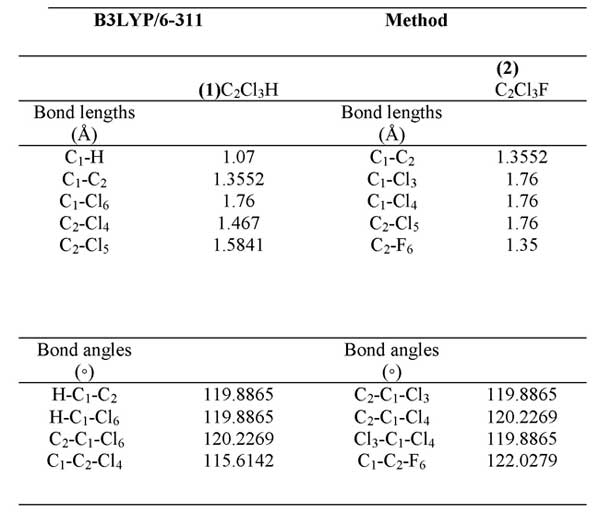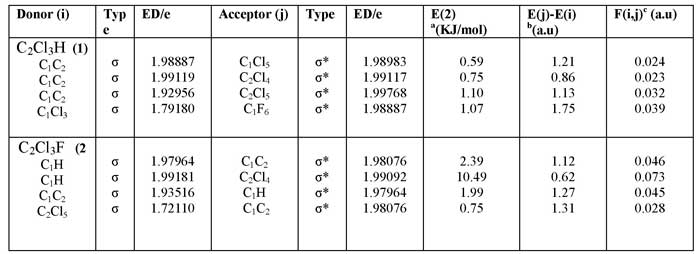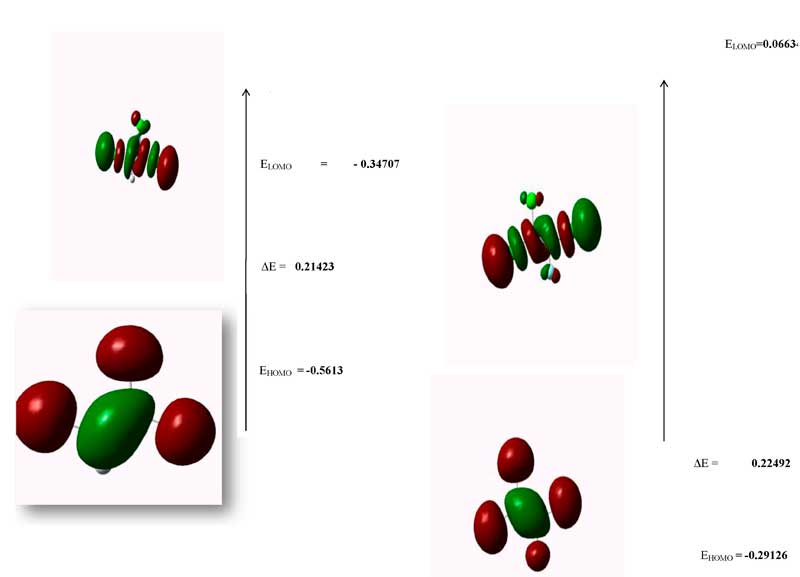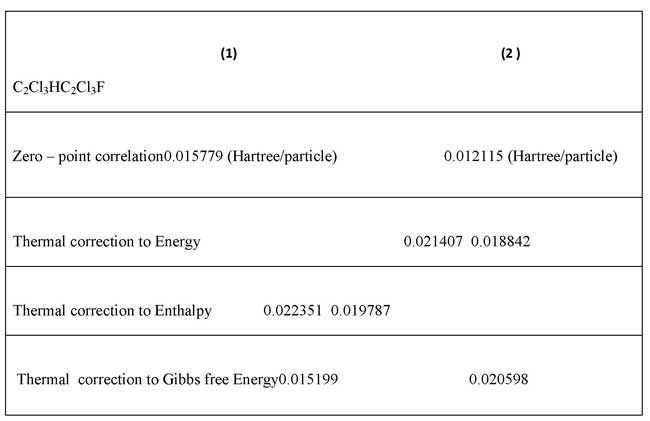Received: November, 2012
Fluorine Notes, 2013, 86, 7-8
Structural Properties,Theory Functional Calculations (DFT), Natural Bond Orbital and Energies for the Two fluorocarbon compounds*
Shahriar Ghammamy1, Ali Rahmani2*
1Department of Chemistry, Faculty of Science, Imam Khomeini International University, Qazvin, Iran
2Department of Chemistry, Faculty of Science, Azad University unit Of Takestan , Takestan, Iran
e-mail: shghamamiii@yahoo.com or Ali_Rahmani870@yahoo.com
Abstract: B3LYP/6-311calculation results indicated that some selected bond length and bond angles values for the C2Cl3H and C2Cl3F In this paper, the optimized geometries and frequencies of the stationary point and the minimum-energy paths of two new compounds with C2Cl3H and C2Cl3F chemical formula are calculated by using the DFT methods with 6-311basis set. The detail group points of two compounds are C1.
Keywords: Electronic structure, Fluorocarbon compounds, DFT Calculations, Vibrational analysis, B3LYP level.
Introduction
Fluoroalkanes can serve as oil-repellent/water-repellent fluoropolymers, solvents, liquid breathing research agents, and powerful greenhouse gases. Fluorocarbon liquids are colorless. They have high density, up to over twice that of water, due to their high molecular weight. Low intermolecular forces give the liquids low viscosities when compared to liquids of similar boiling points. Fluorocarbons, sometimes referred to as semi perfluorocarbons, are organofluorine compounds that contain only carbon and fluorine bonded together in strong carbon–fluorine bonds. Fluoroalkanes that contain only single bonds are more chemically and thermally stable than alkanes. However, fluorocarbons with double bonds (fluoroalkenes) and especially triple bonds (fluoroalkynes) are more reactive than their corresponding hydrocarbons. However, other fluorocarbon based molecules that are not technically fluorocarbons are commonly referred to as fluorocarbons, because of similar structures and identical properties.
Also, low surface tension, heats of vaporization, and refractive indices are notable. They are not miscible with most organic solvents (e.g., ethanol, acetone, ethyl acetate and chloroform), but are miscible with some hydrocarbons (e.g., hexane in some cases). They have very low solubility in water, and water has a very low solubility in them (on the order of 10 ppm). The number of carbon atoms in a fluorocarbon molecule largely determines most physical properties. The greater the number of carbon atoms, the higher the boiling point, density, viscosity, surface tension, critical properties, vapor pressure and refractive index. Gas solubility decreases as carbon atoms increase, while melting point is determined by other factors as well and is thus not readily predicted [1-6].
Fluorocarbons with only single bonds are very stable because of the strength and nature of the carbon–fluorine bond. It is called the strongest bond in organic chemistry. Its strength is a result of the electronegativity of fluorine imparting partial ionic character through partial charges on the carbon and fluorine atoms. The partial charges shorten and strengthen the bond through favorable coulombic interactions. Additionally, multiple carbon–fluorine bonds increase the strength and stability of other nearby carbon–fluorine bonds on the same geminal carbon, as the carbon has a higher positive partial charge. Furthermore, multiple carbon–fluorine bonds also strengthen the "skeletal" carbon–carbon bonds from the inductive effect. Therefore, saturated fluorocarbons are more chemically and thermally stable than their corresponding hydrocarbon counterparts. However, fluoroalkanes are not inert. They are susceptible to reduction through the Birch reduction.
In continuation of our interest to fluorine chemistry, we investigated the structures and properties of the C2Cl3H and C2Cl3F fluorocompounds.[6-13] The structure of the compound has been optimized by using the DFT (B3LYP) method with the 6-311 basis sets, using the Gaussian 09w program. Density functional theory methods were employed to determine the optimized structures of C2Cl3H and C2Cl3F. Initial calculations were performed at the DFT level and split — valence plus polarization 6-311 basis sets were used. Local minima were obtained by full geometrical optimization have all positive frequencies.
Experimental
Chemicals and reagents
The optimized structural parameters were used in the vibrational frequency calculations at the DFT level to characterize all stationary points as minima. All computational are carried out using Gaussian 09w program. Harmonic vibrational frequencies (ν) in cm-1 and infrared intensities (int) in Kilometer per mole of all compounds were performed at the same level on the respective fully optimized geometries. Energy minimum molecular geometries were located by minimizing energy, with respect to all geometrical coordinates without imposing any symmetrical constraints.
NBO (Natural Bond Orbital) study on structures
NBO Calculated Hybridizations are significant parameters for our investigation. The structure of the compound has been optimized by using the DFT (B3LYP) method with the 6-311basis sets, using the Gaussian 09w program. Density functional theory methods were employed to determine the optimized structures of C2Cl3H and C2Cl3F(Table 1, Figure 1).

Figure 1. Optimized geometries of (1)C2Cl3H, (2) C2Cl3F at B3LYP/6-311level of theory.
Table 1. Geometrical parameters optimized for (1)C2Cl3H, (2)C2Cl3F some selected bond lengths (Å) and angles (◦).

Natural Bond Orbital's (NBOs) are localized few-center orbital's that describe the Lewis-like molecular bo nding pattern of electron pairs in optimally compact form. More precisely, NBOs are an orthonormal set of localized "maximum occupancy" orbital's whose leading N/2 members (or N members in the open-shell case) give the most accurate possible Lewis-like description of the total N-electron density. This analysis is carried out by examining all possible interactions between "filled" (donor) Lewis-type NBOs and "empty" (acceptor) non-Lewis NBOs, and estimating their energetic importance by 2nd-order perturbation theory. Since these interactions lead to donation of occupancy from the localized NBOs of the idealized Lewis structure into the empty non-Lewis orbitals (and thus, to departures from the idealized Lewis structure description), they are referred to as "delocalization" corrections to the zeroth-order natural Lewis structure.
Natural charges have been computed using natural bond orbital (NBO) module implemented in Gaussian 09w. The. These quantities are derived from the NBO population analysis. The former provides an orbital picture that is closer to the classical Lewis structure. The NBO analysis involving hybridizations of selected bonds are calculated at B3LYP methods and 6-311 level of theory (Tables 2, 3).
Table2. The NBO Calculated Hybridizations for (1)C2Cl3H, (2) C2Cl3Fat the B3LYP/6-311.

Table 3 Second order perturbation theory analysis of Fock matrix in NBO basis for (1)C2Cl3H, (2) C2Cl3F E(2)a means energy of hyper conjugative interaction (stabilization energy); b Energy difference between donor and acceptor i and j NBO orbital's; c F(i, j) is the Fock matrix element between i and j NBO orbital's.

These data shows the hyper conjugation of electrons between ligand atoms with central metal atom. These conjugations stand on the base of p-d π-bonding. The NBO calculated hybridization for C2Cl3H and C2Cl3F shows that all of compounds have SPX hybridization and non planar configurations. The total hybridization of these molecules are SPX that confirmed by structural. The amount of bond hybridization showed the in equality between central atoms angles (Table 2) shown distortion from normal VSEPR structures and confirmed deviation from VSEPR structures. (Figure 2).

Figure2. The atomic orbital of the frontier molecular orbital for (1)C2Cl3 H, (2) C2Cl3Fat B3LYP/6-311 level of theory
Some thermodynamic parameters Frequencies for (1)C2Cl3H, (2)C2Cl3F Zero-point Energy, correction Energy, Enthalpy lengths, Gibbs free Energy are calculated and confirmed with other published theoretical data ( Table 4).
Table 4. Some thermodynamic parameters Frequencies for (1)C2Cl3H, (2) C2Cl3F Zero-point Energy,correction Energy, Enthalpy lengths, Gibbs free Energy.

Frontier molecular orbital
The HOMO represents the ability to donate an electron, LUMO as an electron acceptor represents the ability to obtain an electron. The HOMO and LUMO energy were calculated by B3LYP/6-311 method. This electronic absorption corresponds to the transition from the ground to the first excited state and is mainly described by one electron excitation from the highest occupied molecular or orbital (LUMO) both the highest occupied molecular orbital (HOMO) and lowest unoccupied molecular orbital (LUMO) are the main orbital take part in chemical stability.. Therefore, while the energy of the HOMO is directly related to the ionization potential, LUMO energy is directly related to the electron affinity. Energy difference between HOMO and LUMO orbital is called as energy gap that is an important stability for structures. In addition, 3D plots of highest occupied molecular orbitals (HOMOs) and lowest unoccupied molecular orbitals (LUMOs) are shown in Figure 2. The HOMO–LUMO energies were also calculated at the6-311and the values are listed in Figure 2, respectively.
Conclusion
In this research we are interested and studied on two fluorocarbon compounds were chosen to theoretical studies. The optimized geometries and frequencies of the stationary point and the minimum-energy paths are calculated by using the DFT (B3LYP) methods with 6-311basis sets. B3LYP/6-311calculation results indicated that some selected bond length and bond angles values for the C2Cl3H and C2Cl3F. The group point of compounds 1-2 are C1.
Acknowledgement
We gratefully acknowledge the financial support from the Research Council of Imam Khoemieni International University by Grant No, 751387-91 and many technical supports that provided by Tarbiat Modaress University.
References
- O'Hagan, D . February 2008. Understanding organofluorine chemistry. An introduction to the C–F bond. Chem. Soc. Rev. 37 (2): 308–19
- Sudha. S,Sundaraganesan.N,Kurt,Cinar.M. 2011 Karabacak, Molecularstructure, vibrational spectroscopic, first order hyperpolarizability and HOMO, LUMO studies of 2-aminobenzimidazole.Journal of Molecular Structure,84: 184-195.
- Lemal, D. M. 2004. Perspective on fluorocarbon c?hemistry. Journal of Organic Chemistry, 69 (1): 1–11.
- Murphy, C.D, Schaffrath, C. O'Hagan D2003Fluorinated natural products: the biosynthesis of fluoroacetate and 4-fluorothreonine in Streptomyces cattleya" Chemosphere,52(2):455-61.
- Lewandowski ,G. Meissner E, Milchert E.Hazard ,J. 2006. Special applications of fluorinated organic compounds.136(3):385–91.
- Becke, A. D. 1993 Density-Functional Thermochemistry. III. The Role of Exact
Exchange. J. Chem. Phys., 98: 5648-5652 - Sundaraganesan, N. and S. Ilakiamani, 2007. Dominic Joshua B Vibrational spectroscopy investigation using ab initio and density functional theory analysis on the structure of 3, 4-dimethylbenzaldehyde. Spectrochimica Acta Part A., 68: 680-687
- Lewis, D. F. V., C. Ioannides, and Parke, D. V. 1994. Interaction of a series of nitriles with the alcohol-inducible isoform of P450: computer analysis of structure- activity relationships. Xenobiotica, 24: 401-408.
- Ralph, G. 1992. Chemical hardness and the electronic chemical potential Inorganic, chimica Acta, 198: 781-786.
- Zhang, W.Curran D.P. 2006. Synthetic Application of Fluorous. Tetrahedron 62: 11837–11865.
- Smith, M. C., Ciao.Y, Wang ,H. andGeorge, S. J. 2005. Coucouvanis D., Koutmos M, Sturhahn W, Alp EA, Zhao J, Kramer SP Normal-Mode Analysis of FeCl4- and Fe2S2Cl42- via Vibrational Mossbauer, Resonance Raman, and FT-IR Spectroscopies.Inorg. Chem., 44: 5562-5570.
- Vrajmasu, V. V., Mu¨nck,E. and E. L. Bominaar, 2004. Theoretical Analysis of the Jahn−Teller Distortions in Tetrathiolato Iron(II) Complexes. Inorg. Chem., 43: 4862–4866.
- Ghammamy, Sh., K. Mehrani,Rostamzadehmansor, S. and Sahebalzamani,H. 2011. Density functional theory studies on the structure, vibrational spectra of three new tetrahalogenoferrate (III) complexes. Natural Science, 3, 683-688.
- Frisch, M. J. Trucks, G. W. 1998. GASSIAN 98 (Revision A. 3) Gaussian Inc., Pittsburgh, PA, USA.
*retained original spelling
Recommended for publication by Prof. S. Igoumnov
Fluorine Notes, 2013, 86, 7-8
